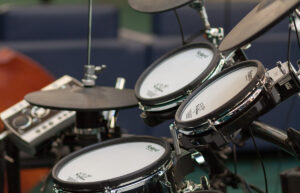How To Play Saxophone: Steps & Essential Accessories

Saxophones are versatile instruments often hard in orchestras and they become the heart of so many tunes. Learning how to play saxophone can help a musician diversify their portfolio, and as for newbies, it is a good instrument to start with. This article will examine how to play saxophone and some important tips to help master it.
Welcome to TheDemoStop, now join the community!
Connect with artists, fans and producers around the world.
What Is Saxophone?
The saxophone is a woodwind instrument known for its distinctive and rich tone. Invented in the 1840s by Belgian inventor Adolphe Sax, the saxophone has become a staple in various musical genres, from jazz and classical to rock and pop. With different sizes and models available, each with its own unique sonic characteristics, the saxophone is a versatile instrument and learning.
Learning To Play The Saxophone
Learning how to play saxophone is an exciting endeavor that requires patience, dedication, and right approach. Let’s explore the essential steps to get you started on mastering this instrument.
1: Choose the Right Saxophone
The first step is to select the right saxophone for your size, skill level, and musical goals. Saxophones come in different sizes, including soprano, alto, tenor, and baritone. As a beginner, an alto or tenor saxophone is generally recommended, as the offer a well-rounded tone and are easier to handle.
2: Assemble Your Saxophone
Once you have your saxophone, you will need to learn how to properly assemble the instrument. This involves attaching the mouthpiece, neck, and other key components.
3: Assemble Your Reeds
The saxophone reed is an important element that contributes to the instrument’s distinctive sound. As a beginner, you’ll need to learn how to properly attach and adjust the reed to the mouthpiece for best performance.
4: Proper Posture and Hand Positioning
While learning how to play saxophone, the correct posture and hand positioning is essential for playing comfortably and efficiently. Sit or stand up straight, with your shoulders relaxed and hold your saxophone at a comfortable angle.
5: Embouchure
The embouchure is the way you position your mouth and lips to play the saxophone. This is important to learn to produce a clear, resonant sound. You can start by gently pressing your lips against the mouthpiece and experiment with different levels of pressure and air support.
6: Focus on Breathing Technique
Proper breathing technique is key to playing the saxophone well. Inhale deeply through your nose and exhale slowly through your mouth, using your diaphragm to control the airflow.
7: Practice Long Tones
Spend time practicing long tones, which involve holding a single note for an extended period. This will help you develop your embouchure, breath control and overall tone quality.
8: Practice Regularly
When you decide to learn how to play saxophone, you need to stay consistent and practice with utmost focus to improve your saxophone skills. Set aside time each day to work on technique exercises, scales and repertoire pieces.
Saxophone Accessories
While the saxophone itself is the primary instrument, there аre many essential accessories that can enhance your playing experience and help you get the most out of your practice and performance.
Reeds
Reeds are thin, vibratile strips that attach to the saxophone’s mouthpiece and are essential for creating sound. When air is blown through the saxophone, the reed vibrates against the mouthpiece, creating sound. Beginners should experiment with different strengths and brands to find reeds that best suit their playing style and embouchure (mouth formation).
Mouthpiece
The mouthpiece is another crucial component of the saxophone. It is the part of the instrument that the musician blows into. Choosing the right mouthpiece is important for achieving the desired sound quality and comfort while playing.
Cork Grease
Cork grease lubricates the cork on the saxophone’s mouthpiece and neck joint. This lubricant helps to ensure a tight seal between the mouthpiece and the neck, preventing air leaks and maintaining proper airflow. Applying cork grease regularly can also prolong the life of the cork by preventing it from drying out and cracking.
Neck Strap
A neck strap is worn around the neck and supports the weight of the saxophone while playing. It attaches to the saxophone’s neck via a hook or loop, allowing the musician to hold the instrument comfortably without straining their neck or shoulders.
Sturdy Case
A sturdy case is essential for protecting the saxophone during storage and transportation. It provides cushioning and support to prevent damage from bumps, scratches, and other potential damage. Quality cases are typically made from durable materials such as hard plastic or wood, with padded interiors to absorb shock and keep the instrument secure.
Metronome
A metronome is an electronic or manual device used to keep time while practicing music. It produces a steady beat at a set tempo, helping musicians develop and maintain a consistent rhythm. Metronomes are especially useful for saxophonists learning new pieces or practicing technical exercises.
Welcome to TheDemoStop, now join the community!
Connect with artists, fans and producers around the world.
Music Stands
Music stands provide a platform for holding sheet music or music books while playing the saxophone. A sturdy music stand that can be set at an appropriate height and helps you to easily read the reference sheet music during practice and performance.
Cleaning Supplies
Swabs and other cleaning tools maintain the saxophone’s hygiene and prevent moisture buildup, which can damage the instrument. Regularly cleaning your saxophone extends its lifespan and preserves its sound quality.
Conclusion
What is saxophone?
The saxophone is a woodwind instrument with a conical bore, a curved body, and a single-reed mouthpiece. It is a versatile instrument known for its distinctive and rich tone.
Learning to play the saxophone
- Choose the right saxophone
- Assemble your saxophone
- Assemble your reeds
- Proper posture and hand positioning
- Embouchure
- Focus on breathing technique
- Practice long tones
Investing in the right accessories
- Reeds
- Mouthpiece
- Cork grease
- Neck strap
- Sturdy case
- Metronome
- Music stands
- Cleaning supplies
FAQs
How to play the saxophone step by step?
- Choose the right saxophone size and model for your skill level and body type
- Assemble the saxophone with other components
- Learn proper posture and hand positioning
- Develop your embouchure by practicing long tones
- Focus on your breathing techniques
- Practice regularly
How long does it take to learn the saxophone?
Many beginners can start playing simple tunes on the saxophone within 6 to 12 months with consistent practice.
What is the easiest saxophone to play?
For beginners, the alto saxophone is generally considered the easiest to start with. The alto sax has a comfortable size and weight, and its range and tone quality make it a great choice for learning the fundamentals of saxophone playing.
Can you learn to play the saxophone?
Self learning to play the saxophone is possible, but it may take more time and effort to progress without the help of a qualified teacher.
What does a saxophone player need?
A saxophonist needs:
- A quality saxophone
- Saxophone reeds
- A mouthpiece
- A neck strap
- A sturdy case
- A metronome
- Music stands and accessories
Can you play the saxophone without reading music?
You can learn some basic saxophone techniques and play simple melodies by ear, being able to read music is highly recommended for any serious saxophonist. Learning to read music should be a priority for any aspiring saxophone player.








































